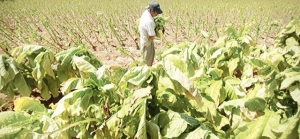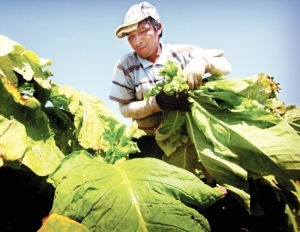Bringing in the crop after the hurricane
By Steve Herring
Published in News on September 1, 2011 1:46 PM

News-Argus/MICHAEL BETTS
Seiso Chavez picks tobacco by hand at Dawl Farms in Pikeville. Hurricane Irene blew over the much of this year's tobacco crop. Farmers are now forced to have the cash crop picked by hand, which is tripling their labor cost.

News-Argus/MICHAEL BETTS
Miguel Gomez gathers the tobacco leaves. Agriculture officials say local crops are facing dire circumstance after Irene.
PIKEVILLE -- Standing on the dirt path that cuts through his family's tobacco patch, fourth generation farmer Paul Daw glances over at the modern automated harvester sitting useless and silent at the edge of the field.
Just as generations of farmers before him, Daw and farmers across eastern North Carolina are having to rely on labor-intensive manual cropping to save as much of their harvest as they can.
Even then, the county's chief cash crop is expected to suffer a 56 percent loss -- about $19 million -- because of Hurricane Irene.
Delayed by drought, tobacco had just begun to recover when Hurricane Irene's almost 20 hours of non-stop winds created a double-calamity for tobacco farmers -- not only did it lay the plants down, it bruised them.
"We are picking out the best field and trying to salvage it before time runs out on us," said Daw as he looked over the field of battered and leaning tobacco plants. "Tobacco that has been bruised is like a bruised piece of fruit. If you have a bruised apple or bruised banana it is not going to last much longer than a few days. The same way with this tobacco -- it is going to spoil.
"It is not good. We think it is salvageable, but it is not going to be good quality at all. But I am making an effort. Nobody can fault me for making an effort. Most farmers are stubborn and are just not willing to give up and are trying to do what they can."
The winds flattened some fields or as in Daw's case, leaned the plants over making it impossible to use harvesters.
Straightening the stalks is labor-intensive since it must be done by hand. The county applied for assistance to help in that undertaking, but was turned down because there is just not enough labor.
"There is so much unknown, but I do not think they can get it out in time," Wayne County Cooperative Extension Service Director Kevin Johnson said. "The best-case scenario is that it will hold out in the field longer, but I don't think that will happen because it is changing so quickly.
"I don't know how long it will stay there. That is one of the big unknowns. Two or three weeks max, but two is more realistic and still maintain (leaf) integrity."
The leaves could last longer in the field, but the quality would be degraded, he said.
Johnson estimates that 75 to 80 percent of the county's crop of almost 10,000 acres was still in the field when Irene hit.
"We were behind because of the drought," Johnson said. "We had started getting rain and tobacco had started filling out and was looking good."
Probably no more than a third of the 100 acres Daw farms with his father, Delanor Daw, had been harvested before Irene pummeled the state.
"That was two primings (croppings), some of it we hadn't even primed yet," Daw said. "Hopefully I will be able to salvage 20 acres out of 100. I'm hoping to save 25 percent all together. Maybe 30 if I am lucky. We have had to hire additional workers."
Since Tuesday Daw and his crew have started at 7 a.m. and worked until 7 p.m. each day
The 12-member crew can strip about three acres a day, but that depends on the number of leaves to crop. The more leaves, the more time it takes, he said
With no history to draw on, Daw said he is unable to guess the cost and time it would take to set the plants up or what the possible loss might be.
"I know it is costing me three times as much to pick it on foot than it would on machine," he said. "Normally what would be $200 a barn is now $600 a barn with the labor."
One section of the field was already stripped by Wednesday afternoon save for an area where it was obvious that the leaves were past saving.
"This is good compared to what some of them are," Daw said. "Seventy-five percent of my acres are flat, on the ground. It is bruised. The leaves are decaying. It is not worth the effort to try to salvage. We came to this field, we think it is our best, and we are going to try. It may be in vain when it comes out of the barn. It is hard to tell. (Curing) is a seven-week process."
Complicating the picture even more is the uncertainty of how tobacco companies will respond to an expected lower quality of leaf.
"We have been informed a few companies will try to help us," he said. "What does that mean? I don't know what the grades will be."
Daw, 38, who has farmed all of his life, said he had never seen such damage, but that some of the old-timers might have.
"I am the fourth generation on this farm," he said. "It is new to me. We don't know what to do, what decisions to make. Everybody is just trying to do what they can."
Daw has crop insurance, but thinks it requires an attempt be made to harvest the crop and there is no guarantee it will cover the cost involved in the crop.
"If you think it is worth harvesting then that is what you do," he said. "Who knows? The clock is ticking. You have got to do something fast. Tobacco is decaying and every day it is getting worse. Time is going to run out on this crop. In 10 days, I would say, and that is being modest, the leaves will be decayed and not worth picking."
Also, because there is so much tobacco that barn space will be at a premium, he said.
His farm suffered no structural damages and like most farmers, the Daws run a diversified operation that includes cotton, soybeans, corn and livestock.
Corn was already devastated by drought.
Daw thinks he will see about a 20 percent loss in his cotton crop. Some plants were blown over and that will hinder use of the mechanical harvester. There could be some boll rot as well, he said.
He thinks soybeans will be "OK."
Daw said he was devastated when he saw the field Sunday morning.
"It is heartbreaking," he said. "Since February in the greenhouse to transplanting it to the field in April, you watch this crop grow. We had a good crop this year. It is saddening and devastating. A farmer is passionate about his crops and we were. You do the best you can then have it blown over with a hurricane it is sad.
"But it is no different than any other businessman who had damages. Farmers aren't the only ones. Not just my farm, every farmer and eastern North Carolina is affected by it. Some are worse than others. The farmers are doing the best that they can to try to salvage the crop. We are just trying to make an effort."
Daw said he and other farmers will do their best and hope for the best and that if "the good Lord is willing" he will be back farming next year.
"That is life we lead, that is the way it is," he said. "The farmer knows that is the risk he takes. You just do the best that you can and move on."
